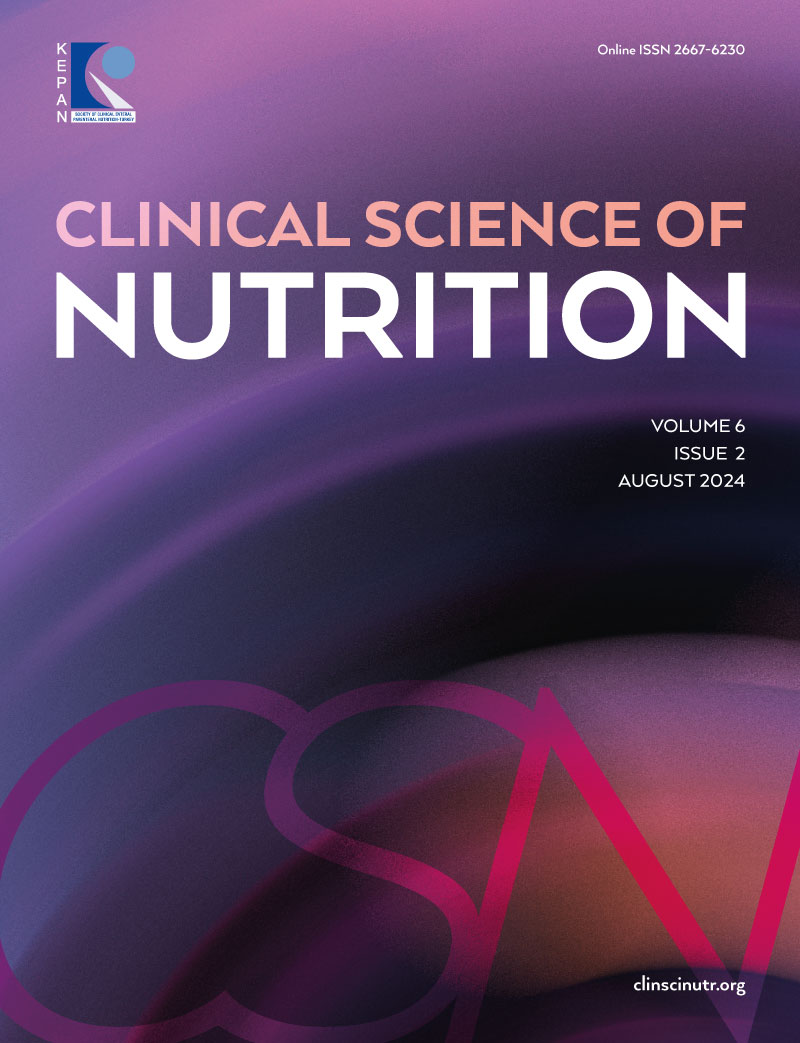Abstract
Objective: Coffee might be effective in the treatment of obesity with its high polyphenol and caffeine content. In this regard, this study aimed to evaluate the effect of different coffee types on body weight, food intake, and biochemical parameters in obese rats.
Methods: Wistar Albino adult male rats were randomly divided into four groups (one control and three coffee groups) after obesity development (after six weeks), and three types of coffee (Turkish coffee, instant coffee, filter coffee) administration were performed for two weeks.
Results: Food consumption was statistically significantly lower in the Turkish coffee (15,6±1,06 g/d) and filter coffee group (16,9±0,8 g/d) compared to the control group (18,5±0,6) in the eighth-week (p<0.001). At the end of two weeks, there is no difference between the groups regarding weight in the rats (p>0.05). However, the body weight gain (g) change was lower in the Turkish coffee group (p<0.001). There was no significant difference between groups in biochemical parameters. However, negative correlations were obtained between NE (ng/L), Leptin (ng/ml), Adiponectin (mg/L), UCP-1 (ng/L), UCP-2 (ng/L), UCP-3 (ng/L) and average energy intake (kcal) in Turkish coffee administrated rats.
Conclusion: According to the study results, coffee consumption, especially Turkish coffee, has a reducing effect on food intake. This effect is likely due to the higher phenolic content of the given Turkish coffee than the same amount of filter and instant coffee. Further studies are needed to explain the effects of coffee consumption on body weight and other casual relationships, especially in the long term.
Keywords: Body weight, obesity, coffee, caffeine
References
- Pozza C, Isidori AM. What's Behind the Obesity Epidemic? In: Laghi A., Rengo M, editors. Imaging in Bariatric Surgery. Springer, Cham; 2018:21-58. https://doi.org/10.1007/978-3-319-49299-5_1
- Kobayashi-Hattori K, Mogi A, Matsumoto Y, Takita T. Effect of caffeine on the body fat and lipid metabolism of rats fed on a high-fat diet. Biosci Biotechnol Biochem. 2005;69:2219-2223. https://doi.org/10.1271/bbb.69.2219
- Yanovski SZ, Yanovski JA. Toward Precision Approaches for the Prevention and Treatment of Obesity. JAMA. 2018;319:223-224. https://doi.org/10.1001/jama.2017.20051
- Sutin AR, Boutelle K, Czajkowski SM, et al. Accumulating Data to Optimally Predict Obesity Treatment (ADOPT) Core Measures: Psychosocial Domain. Obesity (Silver Spring). 2018;26(Suppl 2):S45-S54. https://doi.org/10.1002/oby.22160
- Lin Y, Shi D, Su B, et al. The effect of green tea supplementation on obesity: A systematic review and dose-response meta-analysis of randomized controlled trials. Phytother Res. 2020;34:2459-2470. https://doi.org/10.1002/ptr.6697
- Rao SP, Krishnamurthy V. Herbal Approach for the Management of Obesity - A Review. IJBAP. 2018;6:147-158. https://doi.org/10.18782/2320-7051.6169
- Halvorsen BL, Carlsen MH, Phillips KM, et al. Content of redox-active compounds (ie, antioxidants) in foods consumed in the United States. Am J Clin Nutr. 2006;84:95-135. https://doi.org/10.1093/ajcn/84.1.95
- Choi BK, Park SB, Lee DR, et al. Green coffee bean extract improves obesity by decreasing body fat in high-fat diet-induced obese mice. Asian Pac J Trop Med. 2016;9:635-643. https://doi.org/10.1016/j.apjtm.2016.05.017
- Kolb H, Kempf K, Martin S. Health Effects of Coffee: Mechanism Unraveled? Nutrients. 2020;12:1842. https://doi.org/10.3390/nu12061842
- Saab S, Mallam D, Cox GA, Tong MJ. Impact of coffee on liver diseases: a systematic review. Liver Int. 2014;34:495-504. https://doi.org/10.1111/liv.12304
- Grosso G, Stepaniak U, Micek A, et al. Association of daily coffee and tea consumption and metabolic syndrome: results from the Polish arm of the HAPIEE study. Eur J Nutr. 2015;54:1129-1137. https://doi.org/10.1007/s00394-014-0789-6
- Kim JH, Park YS. Light coffee consumption is protective against sarcopenia, but frequent coffee consumption is associated with obesity in Korean adults. Nutr Res. 2017;41:97-102. https://doi.org/10.1016/j.nutres.2017.04.004
- O'Keefe JH, DiNicolantonio JJ, Lavie CJ. Coffee for Cardioprotection and Longevity. Prog Cardiovasc Dis. 2018;61:38-42. https://doi.org/10.1016/j.pcad.2018.02.002
- Panchal SK, Poudyal H, Waanders J, Brown L. Coffee extract attenuates changes in cardiovascular and hepatic structure and function without decreasing obesity in high-carbohydrate, high-fat diet-fed male rats. J Nutr. 2012;142:690-697. https://doi.org/10.3945/jn.111.153577
- Bonita JS, Mandarano M, Shuta D, Vinson J. Coffee and cardiovascular disease: in vitro, cellular, animal, and human studies. Pharmacol Res. 2007;55:187-198. https://doi.org/10.1016/j.phrs.2007.01.006
- Nilsson C, Raun K, Yan FF, Larsen MO, Tang-Christensen M. Laboratory animals as surrogate models of human obesity. Acta Pharmacol Sin. 2012;33:173-181. https://doi.org/10.1038/aps.2011.203
- Speakman J, Hambly C, Mitchell S, Król E. The contribution of animal models to the study of obesity. Lab Anim. 2008;42:413-432. https://doi.org/10.1258/la.2007.006067
- Marques C, Meireles M, Norberto S, et al. High-fat diet-induced obesity Rat model: a comparison between Wistar and Sprague-Dawley Rat. Adipocyte. 2015;5:11-21. https://doi.org/10.1080/21623945.2015.1061723
- National Research Council. Guide for the care and use of laboratory animals. 8th ed. Washington DC: The National Academy Press; 2011:41-105.
- Novelli EL, Diniz YS, Galhardi CM, et al. Anthropometrical parameters and markers of obesity in rats. Lab Anim. 2007;41:111-119. https://doi.org/10.1258/002367707779399518
- Subcommittee on Laboratory Animal Nutrition, Board on Agriculture, and National Research Council. Nutrient requirements of laboratory animals. 4th ed. Washington DC: National Academy Press; 1995:11-79.
- Abreu RV, Silva-Oliveira EM, Moraes MF, Pereira GS, Moraes-Santos T. Chronic coffee and caffeine ingestion effects on the cognitive function and antioxidant system of rat brains. Pharmacol Biochem Behav. 2011;99:659-664. https://doi.org/10.1016/j.pbb.2011.06.010
- Bukowiecki LJ, Lupien J, Folléa N, Jahjah L. Effects of sucrose, caffeine, and cola beverages on obesity, cold resistance, and adipose tissue cellularity. Am J Physiol. 1983;244:R500-R507. https://doi.org/10.1152/ajpregu.1983.244.4.R500
- Xie C, Cui L, Zhu J, Wang K, Sun N, Sun C. Coffee consumption and risk of hypertension: a systematic review and dose-response meta-analysis of cohort studies. J Hum Hypertens. 2018;32:83-93. https://doi.org/10.1038/s41371-017-0007-0
- Michna L, Lu YP, Lou YR, Wagner GC, Conney AH. Stimulatory effect of oral administration of green tea and caffeine on locomotor activity in SKH-1 mice. Life Sci. 2003;73:1383-1392. https://doi.org/10.1016/s0024-3205(03)00468-5
- Zheng X, Zhu J, Zhang X, Cheng M, Zhang Z, Cao J. The modulatory effect of nanocomplexes loaded with EGCG3ʺMe on intestinal microbiota of high fat diet-induced obesity mice model. J Food Biochem. 2018;42:e12501. https://doi.org/10.1111/jfbc.12501
- Kogure A, Sakane N, Takakura Y, et al. Effects of caffeine on the uncoupling protein family in obese yellow KK mice. Clin Exp Pharmacol Physiol. 2002;29:391-394. https://doi.org/10.1046/j.1440-1681.2002.03675.x
- Lu YP, Lou YR, Li XH, et al. Stimulatory effect of oral administration of green tea or caffeine on ultraviolet light-induced increases in epidermal wild-type p53, p21(WAF1/CIP1), and apoptotic sunburn cells in SKH-1 mice. Cancer Res. 2000;60:4785-4791.
- Sugiyama K, Ohishi A, Muramatsu K. Comparison between the plasma cholesterolelevating effects of caffeine and methionine in rats on a high cholesterol diet. Agric Biol Chem. 1989;53:3101-3103. https://doi.org/10.1080/00021369.1989.10869788
- Alshammari GM, Balakrishnan A, Al-Khalifa A. Antioxidant effect of Arabian coffee (Coffea arabica L) blended with cloves or cardamom in high-fat diet-fed C57BL/6J mice. Trop J Pharm Res. 2017;16:1545. https://doi.org/10.4314/tjpr.v16i7.12
- Cowan TE, Palmnäs MS, Yang J, et al. Chronic coffee consumption in the diet-induced obese rat: impact on gut microbiota and serum metabolomics. J Nutr Biochem. 2014;25:489-495. https://doi.org/10.1016/j.jnutbio.2013.12.009
- Shearer J, Sellars EA, Farah A, Graham TE, Wasserman DH. Effects of chronic coffee consumption on glucose kinetics in the conscious rat. Can J Physiol Pharmacol. 2007;85:823-830. https://doi.org/10.1139/y07-070
- Stefanello N, Schmatz R, Pereira LB, et al. Effects of chlorogenic acid, caffeine, and coffee on behavioral and biochemical parameters of diabetic rats. Mol Cell Biochem. 2014;388:277-286. https://doi.org/10.1007/s11010-013-1919-9
- European Food Safety Authority. Scientific opinion on the safety of caffeine. EFSA Journal. 2015;13:4102.
- Nair AB, Jacob S. A simple practice guide for dose conversion between animals and human. J Basic Clin Pharm. 2016;7:27-31. https://doi.org/10.4103/0976-0105.177703
- Reagan-Shaw S, Nihal M, Ahmad N. Dose translation from animal to human studies revisited. FASEB J. 2008;22:659-661. https://doi.org/10.1096/fj.07-9574LSF
- Organisation for Economic Co-operation and Development. Caffeine, CAS: 58-08-2. SIDS Initial Assessment Report for SIDS Initial Assessment Meeting 14. Paris, France; 2002: 4-7.
- Santin A, Ferracanea R, Mikusova P, et al. Influence of different coffee drink preparations on ochratoxin A content and evaluation of the antioxidant activity and caffeine variations. Food Control. 2011;22:1240-1245. https://doi.org/10.1016/j.foodcont.2011.01.024
- Lee M. Determination of the surface area of the white rat with its application to the expression of metabolic results. Am J Physiol. 1929;89:24-33. https://doi.org/10.1152/ajplegacy.1929.89.1.24
- Taylor BA, Phillips SJ. Detection of obesity QTLs on mouse chromosomes 1 and 7 by selective DNA pooling. Genomics. 1996;34:389-398. https://doi.org/10.1006/geno.1996.0302
- Shimoda H, Seki E, Aitani M. Inhibitory effect of green coffee bean extract on fat accumulation and body weight gain in mice. BMC Complement Altern Med. 2006;6:9. https://doi.org/10.1186/1472-6882-6-9
- Shokouh P, Jeppesen PB, Hermansen K, et al. Effects of Unfiltered Coffee and Bioactive Coffee Compounds on the Development of Metabolic Syndrome Components in a High-Fat-/High-Fructose-Fed Rat Model. Nutrients. 2018;10:1547. https://doi.org/10.3390/nu10101547
- Jia H, Aw W, Egashira K, et al. Coffee intake mitigated inflammation and obesity-induced insulin resistance in skeletal muscle of high-fat diet-induced obese mice. Genes Nutr. 2014;9:389. https://doi.org/10.1007/s12263-014-0389-3
- Mazzone G, Lembo V, D'Argenio G, et al. Decaffeinated coffee consumption induces expression of tight junction proteins in high fat diet fed rats. FFHD. 2016;6:602-611. https://doi.org/10.31989/ffhd.v6i9.268
- Schubert MM, Irwin C, Seay RF, Clarke HE, Allegro D, Desbrow B. Caffeine, coffee, and appetite control: a review. Int J Food Sci Nutr. 2017;68:901-912. https://doi.org/10.1080/09637486.2017.1320537
- Gavrieli A, Karfopoulou E, Kardatou E, et al. Effect of different amounts of coffee on dietary intake and appetite of normal-weight and overweight/obese individuals. Obesity (Silver Spring). 2013;21:1127-1132. https://doi.org/10.1002/oby.20190
- Pettenuzzo LF, Noschang C, von Pozzer Toigo E, Fachin A, Vendite D, Dalmaz C. Effects of chronic administration of caffeine and stress on feeding behavior of rats. Physiol Behav. 2008;95:295-301. https://doi.org/10.1016/j.physbeh.2008.06.003
- Gupta BS. Caffeine and behavior: current views and research trends. Florida: CRC Press; 1999:11-26.
- Song SJ, Choi S, Park T. Decaffeinated green coffee bean extract attenuates diet-induced obesity and insulin resistance in mice. Evid Based Complement Alternat Med. 2014;2014:718379. https://doi.org/10.1155/2014/718379
- Margaryan S, Witkowicz A, Partyka A, Yepiskoposyan L, Manukyan G, Karabon L. The mRNA expression levels of uncoupling proteins 1 and 2 in mononuclear cells from patients with metabolic disorders: obesity and type 2 diabetes mellitus. Postepy Hig Med Dosw (Online). 2017;71:895-900. https://doi.org/10.5604/01.3001.0010.5386
- Muhammad HFL, Sulistyoningrum DC, Huriyati E, Lee YY, Manan Wan Muda WA. The Interaction between Coffee: Caffeine Consumption, UCP2 Gene Variation, and Adiposity in Adults-A Cross-Sectional Study. J Nutr Metab. 2019;2019:9606054. https://doi.org/10.1155/2019/9606054
- Daleprane JB, Cadete B, Moura-Nunes N. Coffee intake mitigated high fat diet-induced whitening of brown adipose tissue in obese mice. The FASEB Journal. 2020;36. https://doi.org/10.1096/fasebj.2022.36.S1.R4491
- Lee CB, Yu SH, Kim NY, et al. Association Between Coffee Consumption and Circulating Levels of Adiponectin and Leptin. J Med Food. 2017;20:1068-1075. https://doi.org/10.1089/jmf.2017.3959
- Shokouh P, Jeppesen PB, Hermansen K, et al. A Combination of Coffee Compounds Shows Insulin-Sensitizing and Hepatoprotective Effects in a Rat Model of Diet-Induced Metabolic Syndrome. Nutrients. 2017;10:6. https://doi.org/10.3390/nu10010006
Copyright and license
Copyright © 2024 The author(s). This is an open-access article under the terms of the Creative Commons Attribution License (CC BY) which permits unrestricted use, distribution, and reproduction in any medium or format, provided the original work is properly cited.










